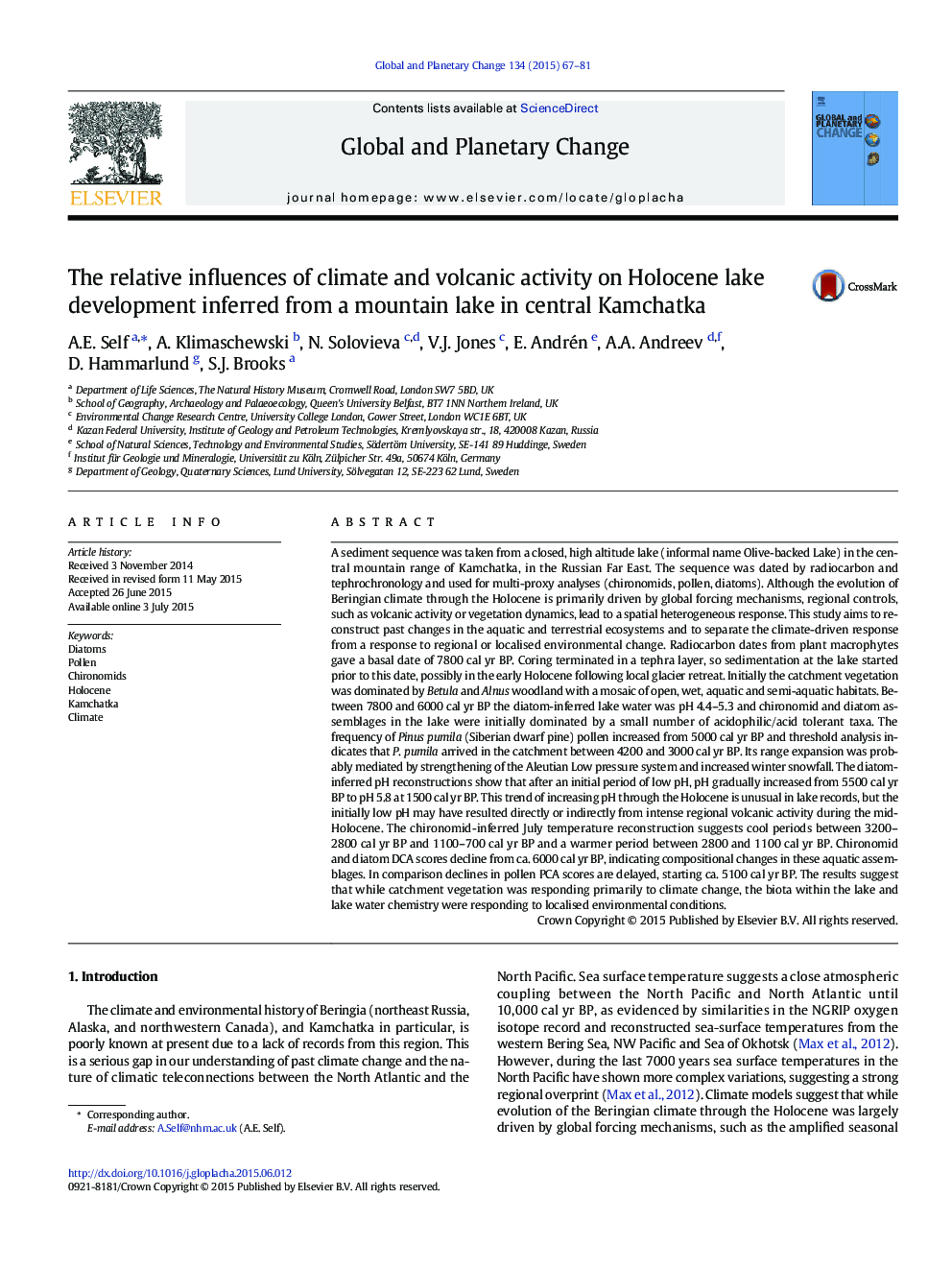| کد مقاله | کد نشریه | سال انتشار | مقاله انگلیسی | نسخه تمام متن |
|---|---|---|---|---|
| 6347998 | 1621648 | 2015 | 15 صفحه PDF | دانلود رایگان |
عنوان انگلیسی مقاله ISI
The relative influences of climate and volcanic activity on Holocene lake development inferred from a mountain lake in central Kamchatka
ترجمه فارسی عنوان
تأثیرات نسبی فعالیت های آب و هوایی و آتشفشانی بر توسعه دریاچه ی گلوتن از یک دریاچه ی کوه در کامچیتک مرکزی
دانلود مقاله + سفارش ترجمه
دانلود مقاله ISI انگلیسی
رایگان برای ایرانیان
کلمات کلیدی
موضوعات مرتبط
مهندسی و علوم پایه
علوم زمین و سیارات
فرآیندهای سطح زمین
چکیده انگلیسی
A sediment sequence was taken from a closed, high altitude lake (informal name Olive-backed Lake) in the central mountain range of Kamchatka, in the Russian Far East. The sequence was dated by radiocarbon and tephrochronology and used for multi-proxy analyses (chironomids, pollen, diatoms). Although the evolution of Beringian climate through the Holocene is primarily driven by global forcing mechanisms, regional controls, such as volcanic activity or vegetation dynamics, lead to a spatial heterogeneous response. This study aims to reconstruct past changes in the aquatic and terrestrial ecosystems and to separate the climate-driven response from a response to regional or localised environmental change. Radiocarbon dates from plant macrophytes gave a basal date of 7800 cal yr BP. Coring terminated in a tephra layer, so sedimentation at the lake started prior to this date, possibly in the early Holocene following local glacier retreat. Initially the catchment vegetation was dominated by Betula and Alnus woodland with a mosaic of open, wet, aquatic and semi-aquatic habitats. Between 7800 and 6000 cal yr BP the diatom-inferred lake water was pH 4.4-5.3 and chironomid and diatom assemblages in the lake were initially dominated by a small number of acidophilic/acid tolerant taxa. The frequency of Pinus pumila (Siberian dwarf pine) pollen increased from 5000 cal yr BP and threshold analysis indicates that P. pumila arrived in the catchment between 4200 and 3000 cal yr BP. Its range expansion was probably mediated by strengthening of the Aleutian Low pressure system and increased winter snowfall. The diatom-inferred pH reconstructions show that after an initial period of low pH, pH gradually increased from 5500 cal yr BP to pH 5.8 at 1500 cal yr BP. This trend of increasing pH through the Holocene is unusual in lake records, but the initially low pH may have resulted directly or indirectly from intense regional volcanic activity during the mid-Holocene. The chironomid-inferred July temperature reconstruction suggests cool periods between 3200-2800 cal yr BP and 1100-700 cal yr BP and a warmer period between 2800 and 1100 cal yr BP. Chironomid and diatom DCA scores decline from ca. 6000 cal yr BP, indicating compositional changes in these aquatic assemblages. In comparison declines in pollen PCA scores are delayed, starting ca. 5100 cal yr BP. The results suggest that while catchment vegetation was responding primarily to climate change, the biota within the lake and lake water chemistry were responding to localised environmental conditions.
ناشر
Database: Elsevier - ScienceDirect (ساینس دایرکت)
Journal: Global and Planetary Change - Volume 134, November 2015, Pages 67-81
Journal: Global and Planetary Change - Volume 134, November 2015, Pages 67-81
نویسندگان
A.E. Self, A. Klimaschewski, N. Solovieva, V.J. Jones, E. Andrén, A.A. Andreev, D. Hammarlund, S.J. Brooks,
